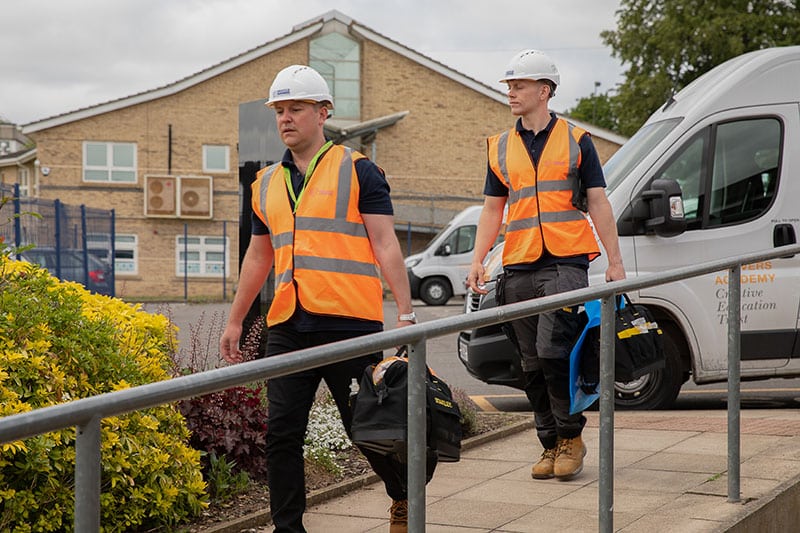What is RAAC, What Are the Dangers & Why Do I Need an Asbestos Survey Before I Inspect it?
In May 2023, the United Kingdom’s Defence Infrastructure Organisation (DIO) published a safety alert about the failure of RAAC planks. The purpose of the report was to communicate concerns and risks related to RAAC. Several trusts in the UK, including the Department for Education, are involved in teaching people about the issues related to RAAC in buildings and are working to have the risks resolved.

What is RAAC?
RAAC stands for reinforced autoclaved aerated concrete. It’s a lightweight form of concrete that is most often used in roofing, and it’s also found in cladding, flooring, and walls. RAAC has visible “bubbles” and a crumbly, powdery texture if handled. It’s much softer than other types of concrete, and it sounds hollow under impact.
You can’t always tell that RAAC exists by sight alone. For example, it’s possible that ceiling panels will have to be removed to expose RAAC or that you’ll need access to a loft if the roof is hidden within the structure. Also, the appearance of RAAC may be different if it’s been coated or painted.
While it continues to be used today, the biggest concerns are RAAC planks in UK buildings from the 1950s to the 1980s. The lifespan of RAAC planks is approximately 30 years. For planks installed in the late 1980s, that time period is long past; planks used in construction before that are even further beyond their end date.
What risks do RAACs pose?
Even small hairline cracks can lead to severe deterioration and collapse of RAAC planks. Deterioration and other signs of wear and tear are further facilitated by issues like water exposure and incorrectly placed reinforcement bars.
Unfortunately, because of their placement in roofing, along with the fact that RAAC planks are flat, they can be difficult to access for surveying, maintenance, and replacement. And since RAAC is porous and permeable, it’s susceptible to water ingress and can corrode more quickly than regular concrete.
If a floor, roof, or wall collapses, everybody in the area is at risk of physical injury. Most importantly, RAAC negatively impacts the integrity of the building as a whole, which makes it even more dangerous, not to mention costlier to fix.
Since RAAC continues to be manufactured and installed, the largest concern is with planks that are past their expiration date. RAAC planks with an expired lifespan are the ones most likely to collapse. What’s most concerning is that, according to the DIO report, “Recent failures have shown little to no warning of failure.”
A history of RAAC plank failures
There were a number of RAAC plank failure cases in the 1990s, including cracking, displacement, and durability issues. While some planks were replaced or reinforced, the RAAC planks remained in the buildings.
A safety alert was released by the DIO in 2019 following more RAAC plank failures, including a school collapse. In response, the Department for Education (DFE) contacted the owners of school buildings to alert them to the risk and let them know that collapses did not usually have warning signs.
What should you do about RAAC planks in your building?
Anybody responsible for managing, maintaining, or renovating buildings should know if RAAC planks are present.
The University of Loughborough is currently conducting research on RAAC planks, and the DIO recommends that caution be used during inspecting and evaluating RAAC until more guidance is published.
According to Professor Chris Goodier, who is part of the RAAC team at Loughborough, “The Department for Education has requested all of the country’s 20,000-plus schools to check if they contain RAAC, but some still have not, and hence urgently need to.”
If you think your building may contain RAAC, first check the paperwork for the building designs and modifications to see if there’s mention of it.
Next, check the property’s asbestos register to make sure no asbestos-containing materials (ACMs) are present in the ceiling or wherever the RAAC is located.
If you’re unable to carry out the inspections yourself, have a professional come to evaluate the building. They’ll conduct a risk assessment, which will guide you to carry out the necessary work safely.
What’s the connection between asbestos and RAAC?
Both asbestos and RAAC were widely used in the construction and refurbishment of schools, hospitals, and other buildings from the 1950s to the 1980s. It’s possible that asbestos is present in the same areas as RAAC. That means that damaged RAAC planks or work done on RAAC planks could impact ACMs.
Visual inspections of RAAC and ACMs
Visual inspections can determine if the RAAC has defects, like bearing widths that are too small or water damage that could make the planks lose their strength. There are a number of precautions to take when visually inspecting RAAC:
- Roof and/or wall coatings may contain asbestos. They should remain undisturbed to reduce the risk of releasing dangerous asbestos fibres.
- Materials in ceiling voids should not be disturbed.
- Whoever is conducting the inspection should have safe access to the roof.
Inspections should take place regularly to determine if the RAAC planks, along with the state of ACMs, have changed or worsened. It may also be smart to conduct visual asbestos inspections at the same time as RAAC inspections.
Should there be an asbestos survey before assessing RAAC?
Refer to the property’s asbestos register to ensure the areas where RAAC is present do not contain asbestos. If asbestos is present, an asbestos specialist should be called in. It’s possible that they’ll need to break up the RAAC panels so that the resulting asbestos debris and fibres can be properly and safely managed.
Before you have a RAAC survey done, you should have an asbestos survey. It’s common for asbestos consultants to be asked to conduct asbestos surveys before structural engineers access ceiling voids to assess RAAC. This reduces the risk of an asbestos exposure event when structural engineers carry out work on the RAAC materials.

Written by Jess Scott
Jess Scott has been an all-round asbestos consultant since 1996. That’s nearly 3 decades of asbestos knowledge. He spends his time sharing that knowledge with the team at Oracle and with their clients. Jess's goal is, and always has been, to use my expertise in helping people to comply with the law. This legal compliance ultimately helps to protect everyone from the harmful effects of asbestos. Jess has acted as an asbestos expert witness in legal cases and is involved in many asbestos educational activities throughout the UK.
